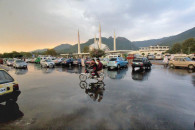Flood of sorrows

There are no guarantees things will improve any time soon. In fact, many aid workers warn they could worsen. Even those not directly affected by floods suffer with the prices of vegetables soaring in Lahore in response to the destruction of farmland and produce across the province. Sufficient resources to cope with a crisis that the UN says affects at least six million are simply not available. And the UN special envoy has warned that the billions of dollars required to support Pakistan’s flood victims for months may not be easy to find in a world facing recession.
This is not a comforting thought. It is quite apparent Pakistan will need substantial help, sustained over a long period of time, if it is to feed people, provide them medical care and, in time, rehabilitate them. Shortages of materials to build shelters are likely to worsen if enough aid does not become available. In the aftermath of the 2005 quake, to which this disaster is being compared, an almost spontaneous effort was launched by tens of thousands of people across the country to help victims. This time too we see philanthropic efforts, but the response is not on the same scale. There may be many factors for this. The floods have crept up more insidiously than the tremor that killed over 73,000 within minutes. There may also be less capacity to give as times grow harder. But the government needs to motivate people to do all they can to help and ensure flood victims are not abandoned in times of immense peril.
Published in The Express Tribune, August 10th, 2010.












COMMENTS
Comments are moderated and generally will be posted if they are on-topic and not abusive.
For more information, please see our Comments FAQ